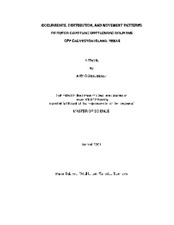| dc.creator | Beier, Amy Gwen | |
| dc.date.accessioned | 2012-06-07T23:02:37Z | |
| dc.date.available | 2012-06-07T23:02:37Z | |
| dc.date.created | 2001 | |
| dc.date.issued | 2001 | |
| dc.identifier.uri | https://hdl.handle.net/1969.1/ETD-TAMU-2001-THESIS-B44 | |
| dc.description | Due to the character of the original source materials and the nature of batch digitization, quality control issues may be present in this document. Please report any quality issues you encounter to digital@library.tamu.edu, referencing the URI of the item. | en |
| dc.description | Includes bibliographical references (leaves 62-71). | en |
| dc.description | Issued also on microfiche from Lange Micrographics. | en |
| dc.description.abstract | Common bottlenose dolphins (Tursiops truncatus) are widely distributed throughout the Gulf of Mexico. Although several dolphin studies have focused on Galveston Bay, Texas, only one has included the adjacent Gulf of Mexico waters. The dolphins of the coastal Gulf of Mexico along Galveston Island were studied from June 1999 to July 2000, and results were compared with those of work dating as far back as 1990. Two techniques were used for observation; shore-based surveys from elevated structures, and boat-based surveys. Dolphins were sighted during all months and times of day, with no apparent peak of occurrence. More groups were sighted, and group size was significantly larger, when shrimp boats were present than when absent. Mean group size was 8.6, which is higher than that found in previous studies inside the bay. A total of 506 individual dolphins were identified, 85% of which were only sighted once. Several individual dolphins were resighted over a period of ten years. Resighted dolphins grouped roughly into four different areas of primary use. Individuals showed greater fidelity to their primary areas than to others, but boundaries were not well defined. The low site fidelity exhibited by dolphins along the outer coast suggests that this is not an area of primary use, but rather an area of overlap of outlying dolphin ranges. The animals may inhabit areas of greater prey distribution in inlet areas, but utilize areas of lower prey abundance for other activities not possible in the bay, such as surfing. While some dolphins appear to show fidelity to the Galveston area, others passed through the study area. These latter dolphins may follow shrimp boats along the coast, easily obtaining prey associated with the boats. The information gathered during this study represents the first detailed description of dolphins of the outer Galveston coast. The population of dolphins is an open one, with some dolphins in the area at all times of year. It is also greatly affected by the shrimp fishery. Due to the high level of human activities, the Galveston area has potential for researchers to use dolphins as long-term indicators of ecosystem change. | en |
| dc.format.medium | electronic | en |
| dc.format.mimetype | application/pdf | |
| dc.language.iso | en_US | |
| dc.publisher | Texas A&M University | |
| dc.rights | This thesis was part of a retrospective digitization project authorized by the Texas A&M University Libraries in 2008. Copyright remains vested with the author(s). It is the user's responsibility to secure permission from the copyright holder(s) for re-use of the work beyond the provision of Fair Use. | en |
| dc.subject | wildlife and fisheries sciences. | en |
| dc.subject | Major wildlife and fisheries sciences. | en |
| dc.title | Occurrence, distribution, and movement patterns of outer coastline bottlenose dolphins off Galveston Island, Texas | en |
| dc.type | Thesis | en |
| thesis.degree.discipline | wildlife and fisheries sciences | en |
| thesis.degree.name | M.S. | en |
| thesis.degree.level | Masters | en |
| dc.type.genre | thesis | en |
| dc.type.material | text | en |
| dc.format.digitalOrigin | reformatted digital | en |


